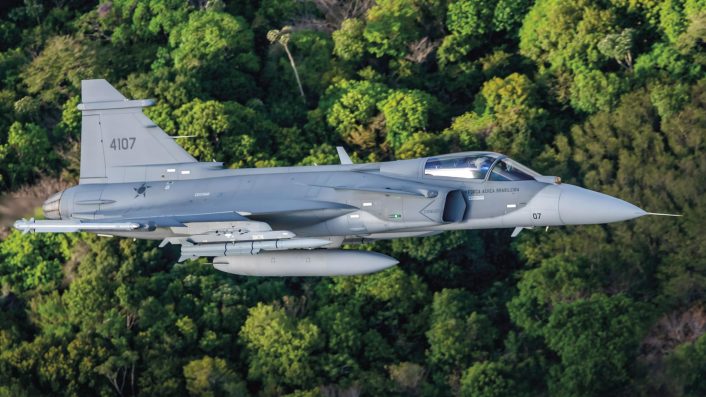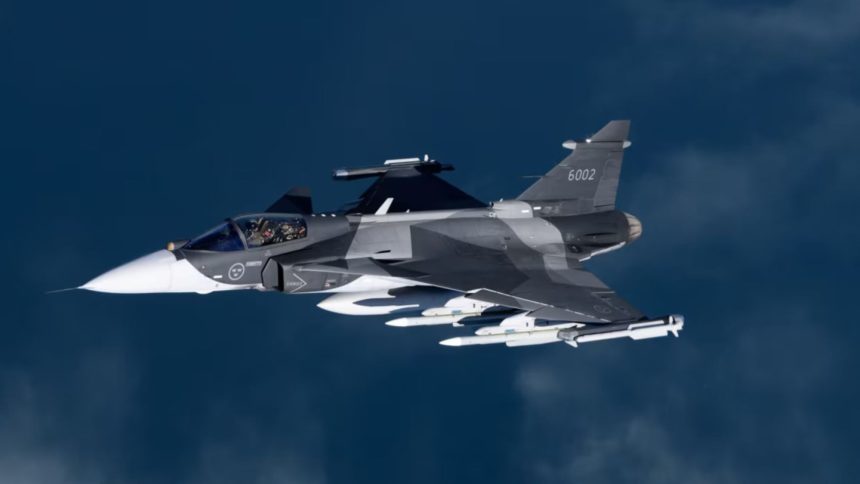Colombia signed a letter of intent for the acquisition of the Gripen E, launching the negotiations which would make the country the type’s second South American operator.
After nearly two years of speculations and unconfirmed reports, Colombia has finally selected Sweden’s Saab JAS39 Gripen as its newest fighter aircraft. Colombian President Gustavo Petro announced the decision on social media, with reports saying a deal will be finalized at the F-AIR Colombia 2025 international airshow.
With the letter of intent signed by his office, the Swedish Ambassador Helena Storm and Saab representatives, Petro said the acquisition would improve the “strategic air defense of Colombia.” Details about the deal, including the number of aircraft and the variants, were not released.
However, Petro mentioned “The fleet of aircraft to be acquired is completely new, with the latest technology, already deployed in Brazil, and is a Saab 39 Gripen brand.” This implies the Fuerza Aerospecial Colombiana (FAC) will acquire the latest JAS39 Gripen E variant, the same used by Brazil.
The Gripen E has a powerful AESA (Active Electronically Scanned Array) radar and a nose-mounted IRST (Infra-Red Search and Track) sensor, among other advancements like a new communications suite, data linking and weapons capabilities. This would also make Colombia the sixth international user of the Saab Gripen, beside the manufacturer’s country Sweden, Brazil, Czech Republic, Hungary, Thailand and South Africa.
BREAKING: #Colombia has selected Saab 39 #Gripen E/F as its future fighter. 🇨🇴🇸🇪
LOI signed. – President Petro Gustavo
Official source: https://t.co/wG5ixXK5hz #military #aircraft pic.twitter.com/lQEcJHMpwD
— Gripen News (@GripenNews) April 3, 2025
After Petro’s announcement, Sweden’s Minister of Defense Pål Jonson wrote on his official X profile that “It is gratifying that President Petro has announced that Colombia is choosing the Gripen as its fighter jet. Negotiations will now begin.” The negotiations will finalize details such as the number of airframes, where the aircraft will be built, timelines, weapons and training.
Mattias Rådström, Saab’s head of media relations, wrote in a statement that “It is very positive for Saab and Sweden that Colombia’s President Petro has announced his intention to acquire the Gripen E/F advanced multi-role fighter.”
Saab in South America
The Brazilian aerospace major Embraer has now been working for a number of years with Saab, manufacturing the jet for the local air force. Considering the jet’s local industrial friendliness and Petro’s mention of possible commercial offsets, the South American industrial base may also be utilized in the larger scheme of things.
This could be to either manufacture the aircraft as a whole for Colombia, requiring a separate diplomatic effort between Brasilia and Bogota, or at least sourcing spares and components for the fleet, simplifying the supply chain and keeping the maintenance and life-cycle costs low. Saab had long wanted to expand its Latin American presence, with the company’s chief Michael Johansson saying in May 2023 that the company wished to see “Brazil to be an exporter to Latin America and potentially other regions.”
The highlight of its 2014 deal with Brazil for 36 Gripen-E/F jets, worth $5.4 billion at the time, was its partnership with Embraer for manufacturing 15 of the jets at its Sao Paolo plant under a ToT (Transfer of Technology) deal. The same model was also pitched for the IAF’s (Indian Air Force) MMRCA (Multi Medium-Role Combat Aircraft), where Saab offered a “100% ToT,” and building a domestic “ecosystem” with “local manufacturing of parts.”
In Colombia’s case, there were already indications that that country would eventually choose the Gripen, given that a full-sized mockup of the aircraft in FAC (Fuerza Aérea Colombiana) colors was displayed during the PISTA23 exhibition. The jet was displayed with a host of air-to-air and air-to-ground payloads like the IRIS-T, Meteor AAMs, the RBS-15, KEPD Taurus 350 air-to-ground missiles and BRU-61A quad-racks carrying GBU-39 SDBs (Small Diameter Bomb).
Saab #Gripen E/F for #Colombia 🇨🇴
Letter Of Intent signed: https://t.co/8jC69HSlEh
Video of mockup: PISTA23 https://t.co/rihiyB9ynm pic.twitter.com/D3LEDMKLgy
— Gripen News (@GripenNews) April 3, 2025
Old Kfirs
Colombia had long been attempting to replace its 20 old IAI (Israeli Aerospace Industries) Kfir jets, acquired in the 1980s, as the airframes have now outlived their useful service life. Based on the French Dassault Mirage V and powered by the General Electric J79 turbojets, 19 Colombian Kfirs are still in service, according to the World Air Forces report of 2024.
In 2017, the FAC was also reported to have acquired the I-Derby-ER AAM (Air-to-Air Missile) for nine of its Kfirs that were being modernized by Israel’s Elta with the EL/M 2052 AESA radar. However, the old airframes and issues with spares swelled maintenance costs to $25,000 per flight hour. The FAC then retired and cannibalized six of the jets for spares.
Colombia also shares the same internal threats posed by drug cartels to Brazil, and, on Mar. 29, 2025, released a video of an “illegal aircraft” that took off from Colombian airspace, headed towards Costa Rica. Brazil is modernizing its A-29 Super Tucanos to network with its Gripens for this very slow-mover intercept role.
#EstrategiaZeus | En una operación multinacional, la #FuerzaAeroespacial🇨🇴, en coordinación con aliados estratégicos, logró la interdicción de una aeronave ilegal que despegó del Pacífico colombiano con rumbo a Costa Rica. El trabajo en equipo y la tecnología avanzada siguen… pic.twitter.com/scUlC0PZ66
— Fuerza Aeroespacial Colombiana (@FuerzaAereaCol) March 29, 2025
Modernization efforts
The first modernization efforts were reported in late 2022, when Colombia held talks with both Saab and France’s Dassault Aviation, but the lack of a sufficient order, standing at only three to five aircraft, was a non-starter for those “initial negotiations.” The Colombian government then finally agreed on a figure of 16 Rafale aircraft with Dassault for $3 billion. Lockheed Martin, offering the F-16, was in the running too. Zona Militar said in Jul. 2024 that this decision was subsequently “reversed.”
This was followed by Reuters quoting Ivan Velasquez in Jan. 2023: “Unfortunately in the pre-negotiations that took place at the end of [last] year, we did not manage to confirm with the French or with the Swedish.” While the reasons behind that cancellation remain unknown, the news agency said that the reported $678 million allocation “expired,” revealing a thin budget.

This was followed by Reuters and Sweden’s Sveriges Radio reports in Nov. 2024 which quoted Velasquez partially confirming the development, affirming that Bogota was considering the Gripen, but that nothing was yet finalized. Both Saab and Velasquez vaguely hinted towards continuing talks, but persistently maintained that the aircraft was not finalized, suggesting an eventual deal was in the offing.









